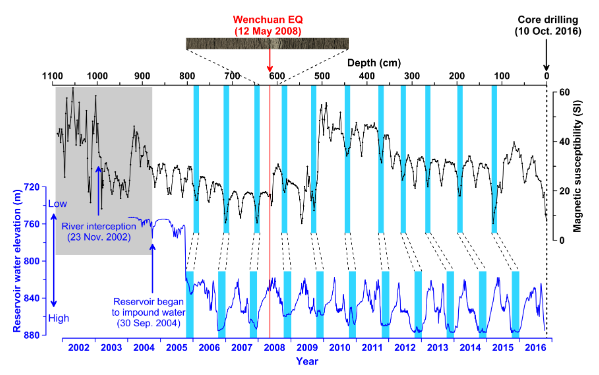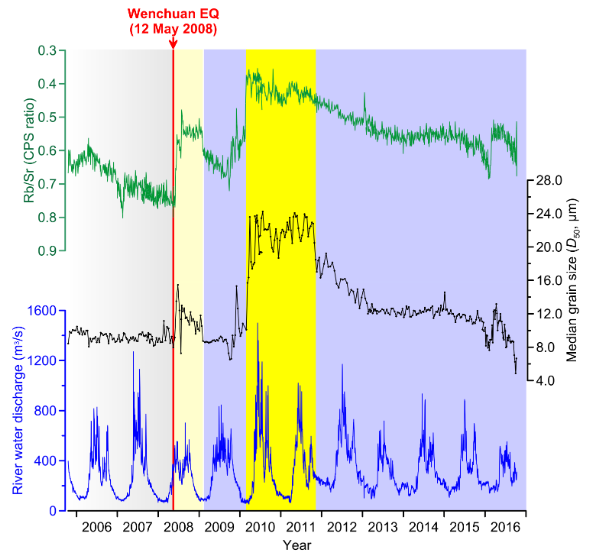Since Molnar and England (1990) questioned that climate change versus tectonic activity is "chicken or eggs" over the geological time scales, the relative roles of "climate" versus "tectonics" that dominate erosion and sediment transport have long been a hot topic in Earth science. How to effectively separate their respective roles is a big challenge. Raymo and Ruddiman (1992) proposed that tectonic uplift of active orogenic belts would accelerate erosion and weathering and then contributethe global cooling via increased atmospheric CO2 consumption, whereas Zhang et al. (2001) suggested that the accelerated global sedimentation rates since 2-4 Ma was the result of accelerated climate variability. Recently, Herman et al. (2013) in Nature concluded that an acceleration in erosion since the past 6 million years was driven by the climate cooling, whichwas casted doubt by a reassessment by Schildgen et al. (2018).
A new study published in Science Advances on 12 June 2019 provided an insight on the interplay between climate and tectonics from a sediment record in the Zipingpu reservoir around the 2008 Wenchuan earthquake, which was led by Prof. JIN Zhangdong from the institute of Earth Evironment of the Chinese Academy of Sciences (IEECAS).
The Zipingpu reservoir with annually-resolved sediments provided a unique opportunity to document the link between a large earthquake and its sedimentary signature, because it was completed in September 2004 and is located downstream of the area impacted by the 2008 Wenchuan earthquake. In October 2016, a 10.89-m long sediment core back to the river bed was recovered from the Zipingpu reservoir. An age model for the core was developed by the correlation between magnetic susceptibility and reservoir water level and the boundary of the 2008 Wenchuan earthquake was then assigned to the core depth of 6.20 m (Fig. 1).This is for the first time that a10-years sediment core was dated to annual-resolution. Based on the precise annual chronology, the roles of single large earthquake and climate on erosion and sediment transfer were evaluated along with sedimentary and hydrometeorological data.

Fig.1 Chronology of the Zipingpu reservoir sediment core based on the correlation between reservoir water level and sedimentary MS(Image by Jin, et al.)
The records demonstrated that the grain size and Rb/Sr ratios of the sediments in the Zipingpu reservoir responded immediately to the earthquake. However, the changes were muted until two years after the event. The most obvious seismic signal occurred in 2010 when intense monsoonal runoff facilicated fast material export and drove accumulation of coarser grains and lower Rb/Sr sediments which were then sustained for several years(Fig. 2). The results indicated that although the earthquake mobilized very large amounts of sediment by landsliding, hydrological forcing was necessary to transport these debris from hillslopes to downstream sediment stores, even in a location proximal to the mountain-front.
The delayed response highlighted the role of intense monsoonal rainfall in propagating tectonic signals into sedimentary archives. This study provided direct evidence that can inform the interpretation of paleorecords and help to illuminate the ways in which sedimentary archives reflected the complex interaction of tectonics and climate in controlling sediment transfer in tectonically-active mountain ranges.

Fig.2 Core sedimentary data from the Zipingpu reservoir and water discharge in the Min Jiang River before and after the 2008 Wenchuan earthquake. (Image by Jin, et al.)
Contact: Bai Jie, Institute of Earth Environment, Chinese Academy of Sciences, Xi'an, China. Email: baijie@ieecas.cn
 © 2015 Institute of Earth Environment,CAS
© 2015 Institute of Earth Environment,CAS Address:No. 97 Yanxiang Road, Xi'an 710061, Shaanxi, China

 Location :
Location :